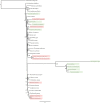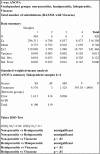Mitochondrial genome evolution in parasitic plants
- PMID: 30961535
- PMCID: PMC6454704
- DOI: 10.1186/s12862-019-1401-8
Mitochondrial genome evolution in parasitic plants
Abstract
Background: Parasitic plants rely on their host to cover their nutritional requirements either for their entire life or a smaller part of it. Depending on the level of parasitism, a proportional reduction on the plastid genome has been found. However, knowledge on gene loss and evolution of the mitogenome of parasitic plants is only available for four hemiparasitic Viscum species (Viscaceae), which lack many of the mitochondrial genes, while the remaining genes exhibit very fast molecular evolution rates. In this study, we include another genus, Phoradendron, from the Viscaceae, as well as 10 other hemiparasitic or holoparasitic taxa from across the phylogeny of the angiosperms to investigate how fast molecular evolution works on their mitogenomes, and the extent of gene loss.
Results: Our observations from Viscum were replicated in Phoradendron liga, whereas the remaining parasitic plants in the study have a complete set of the core mitochondrial genes and exhibit moderate or only slightly raised substitution rates compared to most autotrophic taxa, without any statistically significant difference between the different groups (autotrophs, hemiparasites and holoparasites). Additionally, further evidence is provided for the placement of Balanophoraceae within the order Santalales, while the exact placement of Cynomoriaceae still remains elusive.
Conclusions: We examine the mitochondrial gene content of 11 hemiparasitic and holoparasitic plants and confirm previous observations in Viscaceae. We show that the remaining parasitic plants do not have significantly higher substitution rates than autotrophic plants in their mitochondrial genes. We provide further evidence for the placement of Balanophoraceae in the Santalales.
Keywords: Balanophoraceae; Evolution; Mitogenome; Parasitic plants; Parasitism; Phylogeny; Substitution rates; Viscaceae.
Conflict of interest statement
Ethics approval and consent to participate
Not applicable.
Consent for publication
Not applicable.
Competing interests
The authors declare that they have no competing interests.
Publisher’s Note
Springer Nature remains neutral with regard to jurisdictional claims in published maps and institutional affiliations.
Figures




References
-
- Su H, Hu J, Anderson FE, Der JP, Nickrent DL. Phylogenetic relationships of Santalales with insights into the origins of holoparasitic Balanophoraceae. Taxon. 2015;64:491–506. doi: 10.12705/643.2. - DOI
-
- Wicke S., Muller K. F., de Pamphilis C. W., Quandt D., Wickett N. J., Zhang Y., Renner S. S., Schneeweiss G. M. Mechanisms of Functional and Physical Genome Reduction in Photosynthetic and Nonphotosynthetic Parasitic Plants of the Broomrape Family. The Plant Cell. 2013;25(10):3711–3725. doi: 10.1105/tpc.113.113373. - DOI - PMC - PubMed
Publication types
MeSH terms
LinkOut - more resources
Full Text Sources

